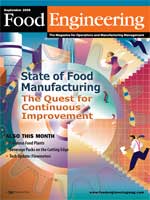
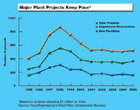
Whether they have formal programs such as Six Sigma and TQM or simply a commitment to continuous quality improvement, all respondents indicated at least one program for better performance is in place. In fact, the need to expand efforts was cited by many in an open-ended question about trends in the industry.
We "need to do lean training," one food professional wrote. Total quality management was cited as a much-needed tool by another, who explained, "more structure to management programs with better results" was the motivating factor. Yet another mentioned total productive maintenance and its effectiveness in "empowering operators to do more."
Industrial engineering concepts like Six Sigma and self-directed work teams have been around for decades, but the popularity of formalized approaches to quality improvement is growing. More than a third of this year's respondents-37.1%-indicated their organizations were using Six Sigma practices. The Theory of Constraints (ToC) may have been obscure a few years ago, but not any more: 16.1% say their companies are using ToC tools such as critical change project management. The popularity of the Toyota Production System has spread far beyond auto manufacturing, with almost three out of five respondents (57.5%) indicating their food companies are implementing lean manufacturing practices. Only Total Quality Management has more adherents (62.9%), while four out of five say some type of continuous quality improvement program is in place.
Twenty years of experience in the food industry is typical for Food Engineering readers. This year's study tapped that tenure for a seasoned perspective of where outsourcing has increased. Outsourcing of engineering projects topped the list, with 57.5% saying this activity had increased. Both manufacturing and maintenance outsourcing have increased, according to 35.1%, closely followed by third-party sanitation services. Globalization also is evident: 16.4% note an increase in manufacturing moving off shore, and 8.2% report growth in the number of engineering projects moving off shore.
More than a quarter of respondents' firms (28.9%) are doing more outsourcing this year than in 2005.
In a related question, surveyed professionals were presented with a list of 14 organizational changes and were asked which ones occurred at their companies in the last year (see chart on page 64). Increased outsourcing ranked fourth, with almost three in ten saying outsourcing was on the increase. Five years ago, the trend was cited by only one in ten, and the proportion has grown steadily since then.
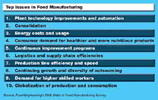
Automate or perish
Outsourcing and organizational issues aren't the only concerns of food professionals, of course. Automation tops their list, whether it involves staffing cuts, data capture challenges or technical improvements. Consolidation remains an area of concern, though it is more a matter of internal efficiency than merger fallout. Acquisitions of food and beverage companies are at their lowest point in at least 13 years, according to the Food Institute's annual mergers and acquisitions report.Forces outside the four walls of the plant are likely to have as great an impact on operations as internal forces, many respondents believe. Bird flu and Mad Cow disease were cited by some professionals as causes for concern, and global competition is forcing manufacturers to be more nimble in the processes they use and the products they make. One respondent sees "competition from China" shaping up as a change-agent over the next five years, adding that competition "will be countered by new product research and development."
Competition for grain could have a major impact on food processors, one reader points out, both from a raw materials and livestock feed perspective. If large amounts of corn are diverted to ethanol production, processors and their suppliers could face higher prices and shorter supplies.
Increased consumer attention to diet and the nutritional aspects of the food they eat are impacting production, as well. "Consumer demand requires higher quality," one respondent wrote. "Ethnic-food tastes influence volume of what is produced," adds another, "shifting toward organics, more expensive ingredients and steps to maintain quality."

How food manufactueres will deploy the tools of automation to meet these challenges is beginning to change, with industrial PCs playing a larger role. Programmable logic controllers (PLCs) remain the most frequently mentioned process control hardware or software item that will be purchased for facilities this year, but the percentage of purchasers dropped below two-thirds for the first time this millennium. While 64% will purchase PLCs this year, 83% bought them last year. Government mandates and customer demands for better ingredient and finished goods accountability pushed product tracking and tracing systems to the second most-common purchase, with 43.3% planning to automate these records.

Controls for CIP and other sanitation functions also are an area of interest, with 24% planning to install them this year.
Asked specifically about maintenance-related automation, almost half (45%) said their plant will make investments in this area this year. Long-term paybacks typically are expected from maintenance automation, yet two in five report returns of 10% or better (see chart on page 66). One in ten say the investment hasn't produced any returns yet.
While Wal-Mart's ardor for RFID has cooled, manufacturers are seeing more value in the technology to help improve supply-chain integration. Almost two in five respondents-39.7%-indicated their firms are investigating or implementing RFID systems. Other popular tools are supply chain software (37.4%), EDI for ordering and invoicing (35.1%) and web-enabled access of customers' order status and other data (34.5%). Fewer than one quarter indicate little or nothing is being done to make improvements.

Maxed-out capacity?
Respondents were asked about expected changes in throughput rates. For almost half, increases of 6% or less over 2005 rates are forecast, with 21.9% expecting throughput to increase 3% or less, and 27.5% forecasting increases of 4-6%. It's the largest concentration of modest throughput-improvements in years and compares to 44% in the 6% or less group in 2004 and 19% in 2002. Similarly, the proportion expecting higher throughput gains is off, though about a quarter of the sample expects gains of 10% or better.Only a handful expect throughput at their plant or company to decline this year, either by a little or a lot. Plant shutdowns were the leading cause of major declines in throughput; one respondent wrote "moving production to another country" in explaining the drop-off.
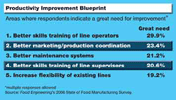
The ratio indicating increases in budgets for this type of equipment was 44.9%, the highest proportion in the 21st Century. The average increase is 14.4%. Similarly, the ratio of plants with budget cuts in these categories was the lowest in years at 8.7%, almost half the previous year's ratio.
Automation and control budgets remain bullish, with the highest proportion of respondents (40.5%) in years indicating spending on hardware and software will increase this year. Only 7.1% expect to spend less on automation and control, the lowest proportion in four years. Budgeted spending is up an average of 13.1%.
Investments in automation often mean workforce reductions, and one in five food professionals say downsizing of manufacturing staff occurred at their company in the last year. Almost as many-14.4%-saw cuts in engineering staff. But downsizing was surpassed by manpower increases: 19.1% added engineers and 26.8% beefed up manufacturing staffs, both highwater marks over the last five years. Plant expansions (55.7%), additional production shifts (22.2%), new lines (39.7%) and new plants (16%) also were at their highest levels since 2002.
While fewer engineers and operations managers are wrestling with the fallout of mergers and acquisitions, the challenges they face and their complexity remain consistent. The exception is integration of manufacturing systems: more than half the sample (54.5%) identified manufacturing integration as a major challenge, moving it from fourth to first on the difficulty list. Integration of warehouse operations and distribution systems was the second biggest issue (see chart on page 64).
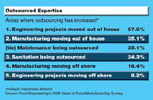
Training of maintenance personnel, operators and others remains a notable need. Another chronic problem is communications based, whether it is communications between different groups in the plant, within the organization or with customers. Some believe salvation lies in continuous improvement programs. "We need quicker response to changes in the marketplace," one professional wrote. "Six Sigma and lean manufacturing will help achieve this."
Whether the path to improved performance is marked by increased spending on systems and machinery, human capital, or both, engineers and managers in the frontlines of food production recognize improvement is a quest and not a destination.


